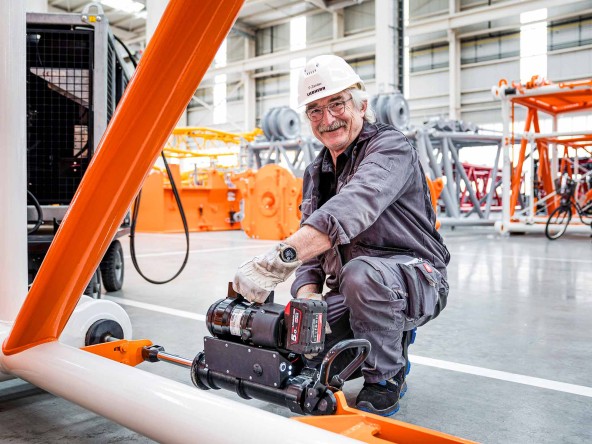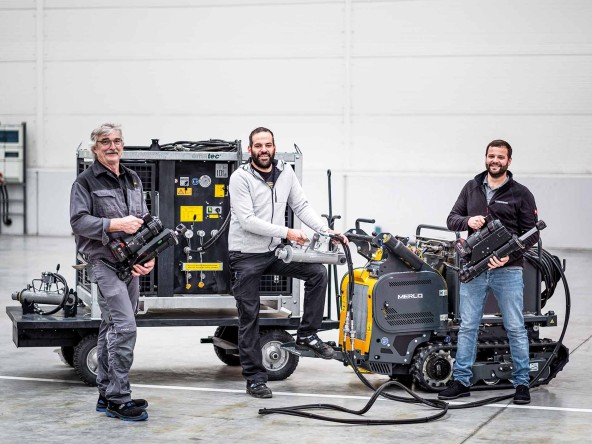
5 minutes - magazine 02 | 2024
Pin removal made easy
A hammer and muscle power wonʼt get you very far when pinning or unpinning the lattice booms on our crawler cranes. This task requires hydraulic power.
We offer precisely this in the form of the BZGF 18.2 hydraulic power pack and the Cingo M 8.3 EVO crawler tractor. In this issue, our experts Mathias Waidmann and Peter Zander from the crane acceptance department and design engineer Frank Meixner present an alternative approach that makes this work easier and more convenient.

Easy as pie: Peter Zander demonstrates the function of the battery-powered pin-pulling cylinder.
It is proven true time and time again: The best ideas come from practical experience. Mathias Waidmann is familiar with these problems in his day-to-day work as a foreman on the crawler crane acceptance line: “The hydraulic units are heavy and therefore have to be moved on vehicles. We have flat concrete surfaces at our acceptance centre, so itʼs actually possible there. But things are usually different on construction sites. This is where the Cingo crawler tractor comes into its own. But with both devices you always have to handle hydraulic hoses. I thought to myself, there must be a simpler, handier and more mobile alternative.”
Inspired by fire-fighting technology
Waidmann benefited from his experience as a fire-fighter: “In the fire service, we have battery-powered hydraulic rescue rams that are used to prise open the passenger compartments of vehicles involved in accidents in order to rescue people. This gave me the idea that this technique could also be used to pin together lattice boom sections. I then submitted this idea via our company suggestion scheme.”
Frank Meixner was entrusted with producing a workable design: “Our long-standing supplier Weber-Hydraulik was an ideal partner for this project, as the Weber Rescue Systems division supplies battery-powered rescue rams. Together, we now had to adapt the existing technology to meet our requirements.”
On the application side, Peter Zander was involved in realising the design: “It turned out that we could manage with just two cylinder stroke lengths: 260 millimetres for cranes with a lifting capacity of 600 to 800 tonnes, and 310 millimetres for the LR 11000 and the LR 12500-1.0.”

Mission successful: The battery-powered pin-pulling cylinder is a convenient alternative to the BZGF 18.2 hydraulic power pack and the Cingo M 8.3 EVO crawler tractor for pinning or unpinning lattice type sections. From left to right: Peter Zander, Mathias Waidmann and Frank Meixner.
With remote control – safety first
Of course, there were also challenges to overcome. Meixner reports: “Compared to the rescue ram, we not only need high compressive forces when extending the cylinder, but also have to apply tensile forces to the piston rod so that we can pull the pins out of the fork-finger connection again when disassembling the boom. Itʼs precisely during this process that the operator is exposed to increased danger when operating the battery cylinder on the appliance. When the last pin is pulled, the released component can move in an unpredictable direction. This made it clear to us that we had to offer a way to operate the cylinder remotely. And that was precisely the challenge. As there was no remote control for the rescue rams, we developed one together with the supplier.”
The cylinder can be moved with reduced force using a button on the device when positioning it in the pin-pulling bracket. As soon as a predefined force threshold is exceeded, the device switches off and you have to switch to remote control. In this operating mode, a compressive force of around 85 kN and a tensile force of 70 kN are achieved at 230 bar.
Everyone involved is delighted with the result. “Of course, Iʼm pleased that we were able to implement my idea. The battery-powered pin-pulling cylinder weighs just 16 kilos and is easy to use in practice,” says Waidmann.
Zander adds: “Safety is also increased because there are no hoses to trip over. Several pin-pulling cylinders can even work simultaneously, which shortens the assembly time. Even if the extension and retraction times are slightly longer compared to the hydraulic units, the faster and more convenient handling outweighs this. Furthermore, the cylinders emit neither exhaust gases nor CO2 during operation.”
The scope of delivery includes two 28-volt batteries with 5 Ah each, a mains charger and a 12/24-volt on-board charger. This enables almost continuous operation. The batteries are produced by the global manufacturer Milwaukee and are therefore available worldwide.
We delivered the first battery-powered pin-pulling cylinders to our customers at the beginning of 2023. Dozens are now in operation and the feedback is consistently positive.
Advantages of the battery-powered pin-pulling cylinder
- Low weight, approx. 16 kilograms
- No hose handling
- Local Zero Emission
- No dependence on fossil fuel, no fuel handling
- “Continuous operation” thanks to second battery and on-board charger
- Global battery availability (Milwaukee)
This article was published in the UpLoad magazine 02 | 2024.



